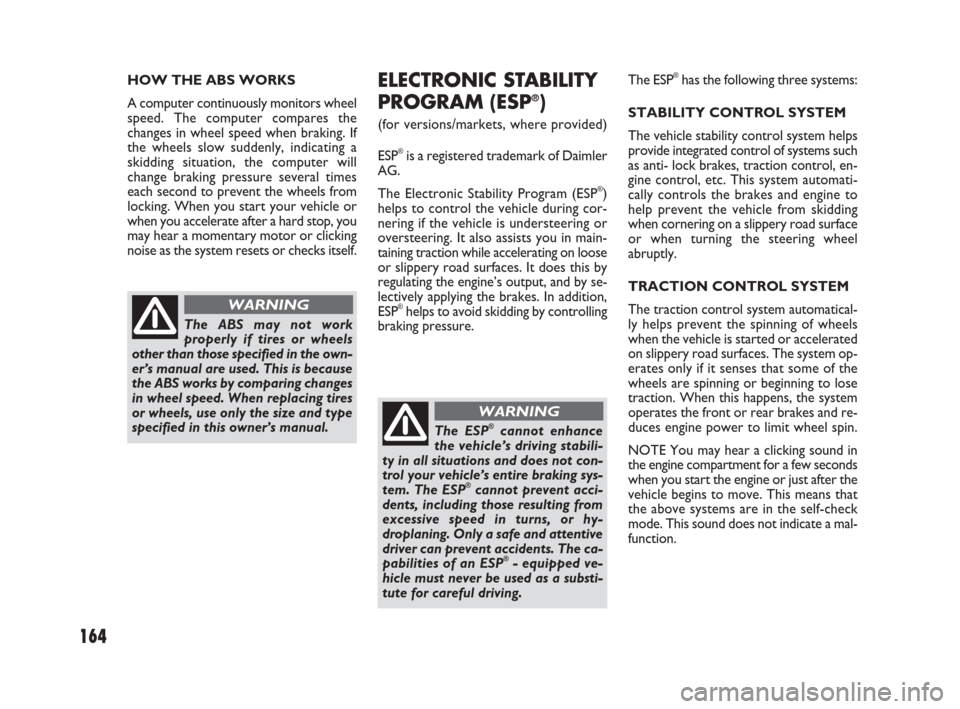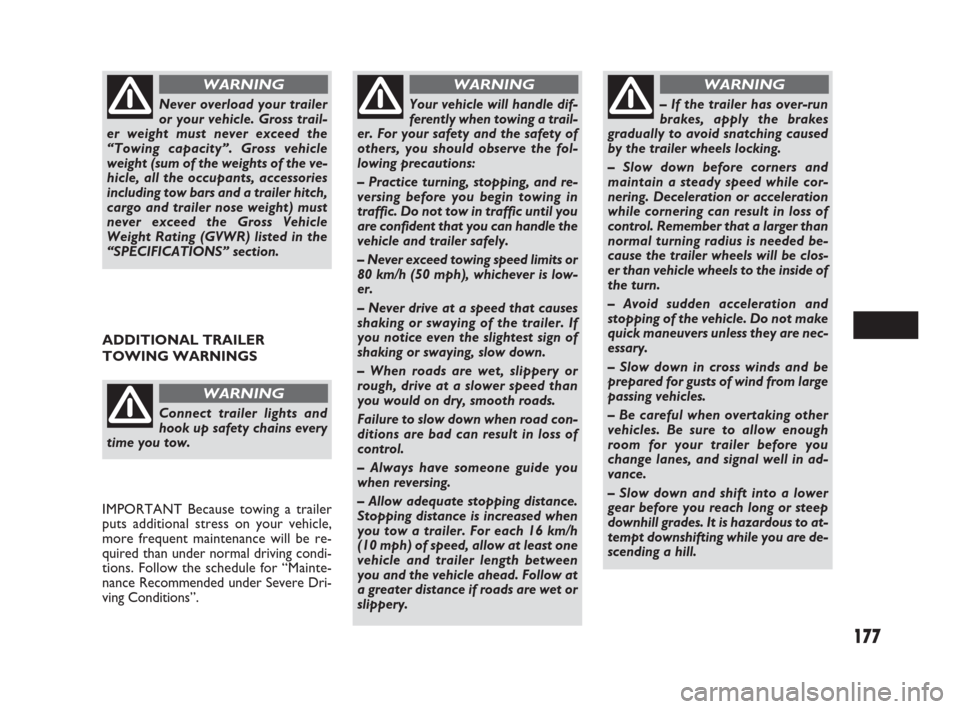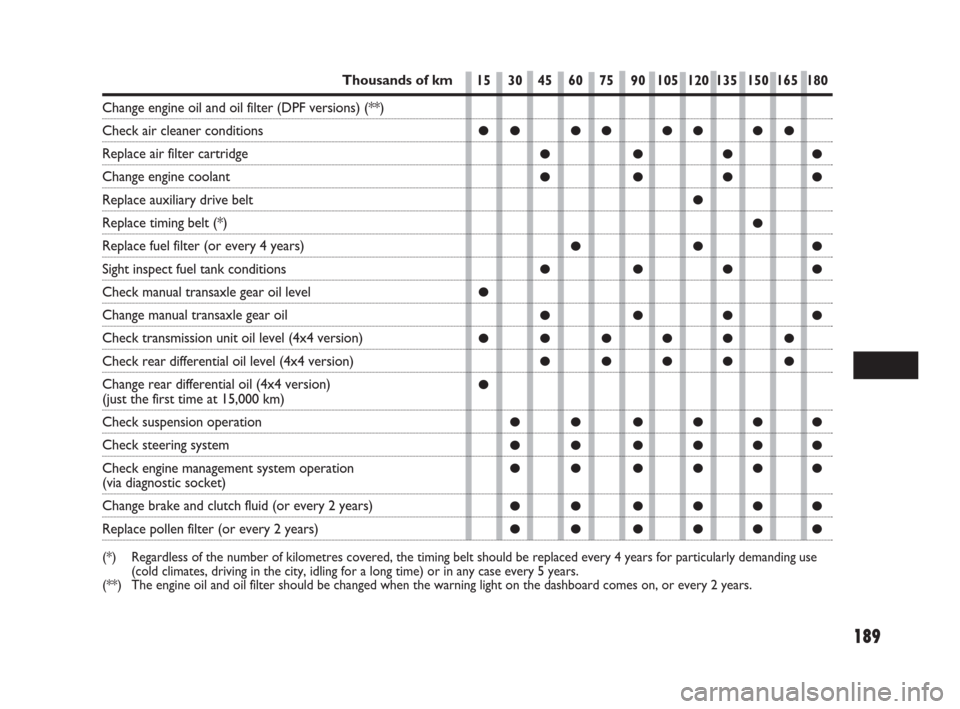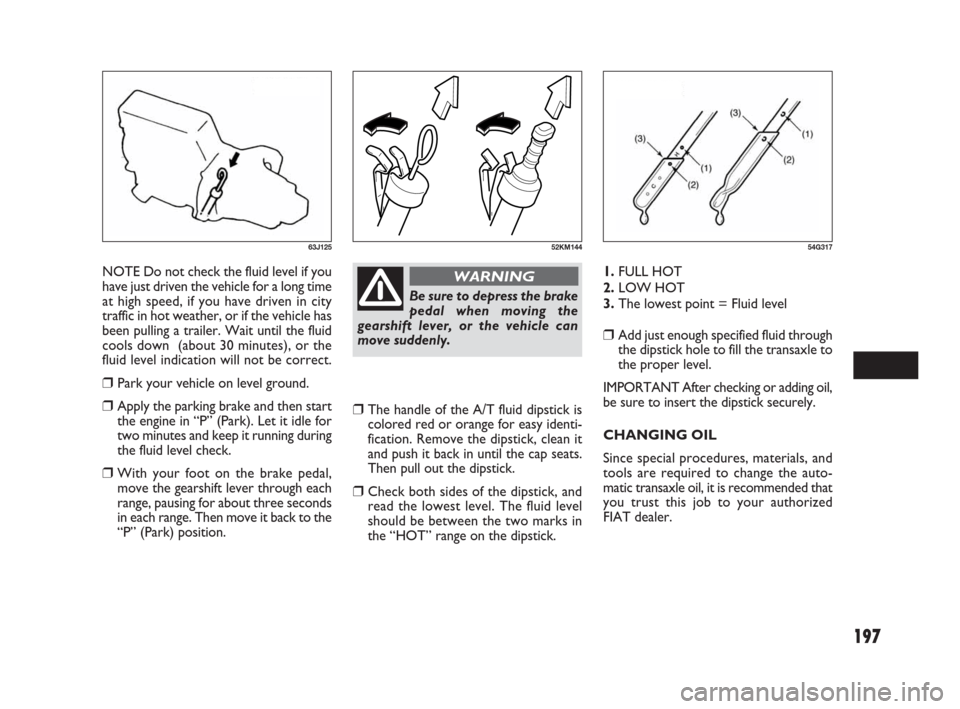2009 FIAT SEDICI change time
[x] Cancel search: change timePage 165 of 270

164
HOW THE ABS WORKS
A computer continuously monitors wheel
speed. The computer compares the
changes in wheel speed when braking. If
the wheels slow suddenly, indicating a
skidding situation, the computer will
change braking pressure several times
each second to prevent the wheels from
locking. When you start your vehicle or
when you accelerate after a hard stop, you
may hear a momentary motor or clicking
noise as the system resets or checks itself.
The ABS may not work
properly if tires or wheels
other than those specified in the own-
er’s manual are used. This is because
the ABS works by comparing changes
in wheel speed. When replacing tires
or wheels, use only the size and type
specified in this owner’s manual.
WARNING
ELECTRONIC STABILITY
PROGRAM (ESP®)
(for versions/markets, where provided)
ESP
®is a registered trademark of Daimler
AG.
The Electronic Stability Program (ESP
®)
helps to control the vehicle during cor-
nering if the vehicle is understeering or
oversteering. It also assists you in main-
taining traction while accelerating on loose
or slippery road surfaces. It does this by
regulating the engine’s output, and by se-
lectively applying the brakes. In addition,
ESP
®helps to avoid skidding by controlling
braking pressure.
The ESP®cannot enhance
the vehicle’s driving stabili-
ty in all situations and does not con-
trol your vehicle’s entire braking sys-
tem. The ESP
®cannot prevent acci-
dents, including those resulting from
excessive speed in turns, or hy-
droplaning. Only a safe and attentive
driver can prevent accidents. The ca-
pabilities of an ESP
®- equipped ve-
hicle must never be used as a substi-
tute for careful driving.
WARNING
The ESP®has the following three systems:
STABILITY CONTROL SYSTEM
The vehicle stability control system helps
provide integrated control of systems such
as anti- lock brakes, traction control, en-
gine control, etc. This system automati-
cally controls the brakes and engine to
help prevent the vehicle from skidding
when cornering on a slippery road surface
or when turning the steering wheel
abruptly.
TRACTION CONTROL SYSTEM
The traction control system automatical-
ly helps prevent the spinning of wheels
when the vehicle is started or accelerated
on slippery road surfaces. The system op-
erates only if it senses that some of the
wheels are spinning or beginning to lose
traction. When this happens, the system
operates the front or rear brakes and re-
duces engine power to limit wheel spin.
NOTE You may hear a clicking sound in
the engine compartment for a few seconds
when you start the engine or just after the
vehicle begins to move. This means that
the above systems are in the self-check
mode. This sound does not indicate a mal-
function.
149-168 SEDICI LUM FL GB 1E 19-06-2009 13:33 Pagina 164
Page 178 of 270

177
ADDITIONAL TRAILER
TOWING WARNINGS
Never overload your trailer
or your vehicle. Gross trail-
er weight must never exceed the
“Towing capacity”. Gross vehicle
weight (sum of the weights of the ve-
hicle, all the occupants, accessories
including tow bars and a trailer hitch,
cargo and trailer nose weight) must
never exceed the Gross Vehicle
Weight Rating (GVWR) listed in the
“SPECIFICATIONS” section.
WARNING
Connect trailer lights and
hook up safety chains every
time you tow.
WARNING
IMPORTANT Because towing a trailer
puts additional stress on your vehicle,
more frequent maintenance will be re-
quired than under normal driving condi-
tions. Follow the schedule for “Mainte-
nance Recommended under Severe Dri-
ving Conditions”.
Your vehicle will handle dif-
ferently when towing a trail-
er. For your safety and the safety of
others, you should observe the fol-
lowing precautions:
– Practice turning, stopping, and re-
versing before you begin towing in
traffic. Do not tow in traffic until you
are confident that you can handle the
vehicle and trailer safely.
– Never exceed towing speed limits or
80 km/h (50 mph), whichever is low-
er.
– Never drive at a speed that causes
shaking or swaying of the trailer. If
you notice even the slightest sign of
shaking or swaying, slow down.
– When roads are wet, slippery or
rough, drive at a slower speed than
you would on dry, smooth roads.
Failure to slow down when road con-
ditions are bad can result in loss of
control.
– Always have someone guide you
when reversing.
– Allow adequate stopping distance.
Stopping distance is increased when
you tow a trailer. For each 16 km/h
(10 mph) of speed, allow at least one
vehicle and trailer length between
you and the vehicle ahead. Follow at
a greater distance if roads are wet or
slippery.
WARNING
– If the trailer has over-run
brakes, apply the brakes
gradually to avoid snatching caused
by the trailer wheels locking.
– Slow down before corners and
maintain a steady speed while cor-
nering. Deceleration or acceleration
while cornering can result in loss of
control. Remember that a larger than
normal turning radius is needed be-
cause the trailer wheels will be clos-
er than vehicle wheels to the inside of
the turn.
– Avoid sudden acceleration and
stopping of the vehicle. Do not make
quick maneuvers unless they are nec-
essary.
– Slow down in cross winds and be
prepared for gusts of wind from large
passing vehicles.
– Be careful when overtaking other
vehicles. Be sure to allow enough
room for your trailer before you
change lanes, and signal well in ad-
vance.
– Slow down and shift into a lower
gear before you reach long or steep
downhill grades. It is hazardous to at-
tempt downshifting while you are de-
scending a hill.
WARNING
173-182 SEDICI LUM FL GB 1E 19-06-2009 10:49 Pagina 177
Page 188 of 270

187
15 30 45 60 75 90 105 120 135 150 165 180
●●●●●●●●●●●●
●●●●
●●●●●●●●●●●●
●● ●● ●● ●●
●●●●
●●●●
●●
●●●●
●
●● ●●●
●●●●
●
●●●●●●
●● ●●
●
●● ●●●●
●● ●●●●
●● ●●●●
●● ●●●●
●● ●●●●
Thousands of km
Check cleanliness of locks, bonnet and boot, and cleanliness
and lubrication of linkages
Replace spark plugs (replace iridium spark plugs
every 105,000 km) or every 7 years
Change engine oil and oil filter
Check air cleaner conditions
Replace air filter cartridge
Change engine coolant
Replace auxiliary drive belt
Sight inspect fuel tank conditions
Check manual transaxle gear oil level
Check automatic transaxle gear oil level
Change manual transaxle gear oil
Change automatic transaxle gear oil
Check transmission unit oil level (4x4 version)
Check rear differential oil level (4x4 version)
Change rear differential oil (4x4 version)
(just the first time at 15,000 km)
Check suspension operation
Check steering system
Check engine management system operation
(via diagnostic socket)
Change brake and clutch fluid (or every 2 years)
Replace pollen filter (or every 2 years)
183-230 SEDICI LUM FL GB 1E 19-06-2009 11:00 Pagina 187
Page 190 of 270

189
15 30 45 60 75 90 105 120 135 150 165 180
●● ●● ●● ●●
●●●●
●●●●
●
●
●●●
●●●●
●
●●●●
●●●●●●
●●●●●
●
●● ●●●●
●● ●●●●
●● ●●●●
●● ●●●●
●● ●●●●
Thousands of km
Change engine oil and oil filter (DPF versions) (**)
Check air cleaner conditions
Replace air filter cartridge
Change engine coolant
Replace auxiliary drive belt
Replace timing belt (*)
Replace fuel filter (or every 4 years)
Sight inspect fuel tank conditions
Check manual transaxle gear oil level
Change manual transaxle gear oil
Check transmission unit oil level (4x4 version)
Check rear differential oil level (4x4 version)
Change rear differential oil (4x4 version)
(just the first time at 15,000 km)
Check suspension operation
Check steering system
Check engine management system operation
(via diagnostic socket)
Change brake and clutch fluid (or every 2 years)
Replace pollen filter (or every 2 years)
(*) Regardless of the number of kilometres covered, the timing belt should be replaced every 4 years for particularly demanding use
(cold climates, driving in the city, idling for a long time) or in any case every 5 years.
(**) The engine oil and oil filter should be changed when the warning light on the dashboard comes on, or every 2 years.
183-230 SEDICI LUM FL GB 1E 19-06-2009 11:00 Pagina 189
Page 191 of 270

MAINTENANCE RECOMMENDED UNDER SEVERE DRIVING CONDITIONS
If the vehicle is usually used under the conditions corresponding to any severe condition code given below, it is recommended that
applicable maintenance operation be performed at the particular interval as given in the chart below.
190
G----
HTrailer towing (if admitted)
Maintenance Operation
IInspect and correct or replace if necessary
RReplace or Change
NOTE 4WD: 4-wheel drive Severe condition code
ARepeated short trips
BDriving on rough and/or muddy roads
CDriving on dusty roads
DDriving in extremely cold weather and/or salted roads
ERepeated short trips in extremely cold weather
FLeaded fuel use
Severe Condition Code
B C D
A D
A C D E F H
A C D E H
A B C E F H
C
B E H
B C D H
B D E H
B E H
C D
Maintenance Interval
Every 15,000 km (9,000 miles) or 12 months
Every 45,000 km (27,000 miles) or 36 months
Every 36 months
Every 7,500 km (4,500 miles) or 6 months
Every 7,500 km (4,500 miles) or 6 months
Every 30,000 km (18,000 miles) or 24 months
Every 10,000 km (6,000 miles) or 8 months
Every 2,500 km (1,500 miles)
Every 30,000 km (18,000 miles) or 24 months
Every 30,000 km (18,000 miles) or 24 months
Every 15,000 km (9,000 miles) or 12 months
Every 15,000 km (9,000 miles) or 12 months
First time only:
15,000 km (9,000 miles) or 12 months
Second time and after:
Every 30,000 km (18,000 miles) or 24 months
reckoning from 0 km (0 mile) or 0 month
Every 15,000 km (9,000 miles) or 12 months
Every 45,000 km (27,000 miles) or 36 months Maintenance
Engine accessory drive belt (V-rib belt)
Camshaft timing belt (Diesel engine)
Engine oil and oil filter (Gasoline engine)
Engine oil and oil filter (Diesel engine)
Spark plugs
Air cleaner filter element
(Inspect or replace more frequently if necessary)
Automatic transaxle fluid change
Wheel bearings
Drive axle boots/Propeller shaft (4WD)
Manual transaxle oil/Transfer oil (4WD)
Differential oil (4WD)
Air conditioner filter element (for versions/markets, where provided)
(Clean more frequently if the air flow from the air conditioner
decreases)Maintenance
Operation
I
R
R
R
R
R
R
I
R
R
I
I
R
I
R Iridium plug
(Highly recommended)
Nickel plug
(Standard type)
183-230 SEDICI LUM FL GB 1E 19-06-2009 11:00 Pagina 190
Page 198 of 270

197
NOTE Do not check the fluid level if you
have just driven the vehicle for a long time
at high speed, if you have driven in city
traffic in hot weather, or if the vehicle has
been pulling a trailer. Wait until the fluid
cools down (about 30 minutes), or the
fluid level indication will not be correct.
❒Park your vehicle on level ground.
❒Apply the parking brake and then start
the engine in “P” (Park). Let it idle for
two minutes and keep it running during
the fluid level check.
❒With your foot on the brake pedal,
move the gearshift lever through each
range, pausing for about three seconds
in each range. Then move it back to the
“P” (Park) position.
❒The handle of the A/T fluid dipstick is
colored red or orange for easy identi-
fication. Remove the dipstick, clean it
and push it back in until the cap seats.
Then pull out the dipstick.
❒Check both sides of the dipstick, and
read the lowest level. The fluid level
should be between the two marks in
the “HOT” range on the dipstick.1.FULL HOT
2.LOW HOT
3.The lowest point = Fluid level
❒Add just enough specified fluid through
the dipstick hole to fill the transaxle to
the proper level.
IMPORTANT After checking or adding oil,
be sure to insert the dipstick securely.
CHANGING OIL
Since special procedures, materials, and
tools are required to change the auto-
matic transaxle oil, it is recommended that
you trust this job to your authorized
FIAT dealer.
63J12552KM14454G317
Be sure to depress the brake
pedal when moving the
gearshift lever, or the vehicle can
move suddenly.
WARNING
183-230 SEDICI LUM FL GB 1E 19-06-2009 11:00 Pagina 197